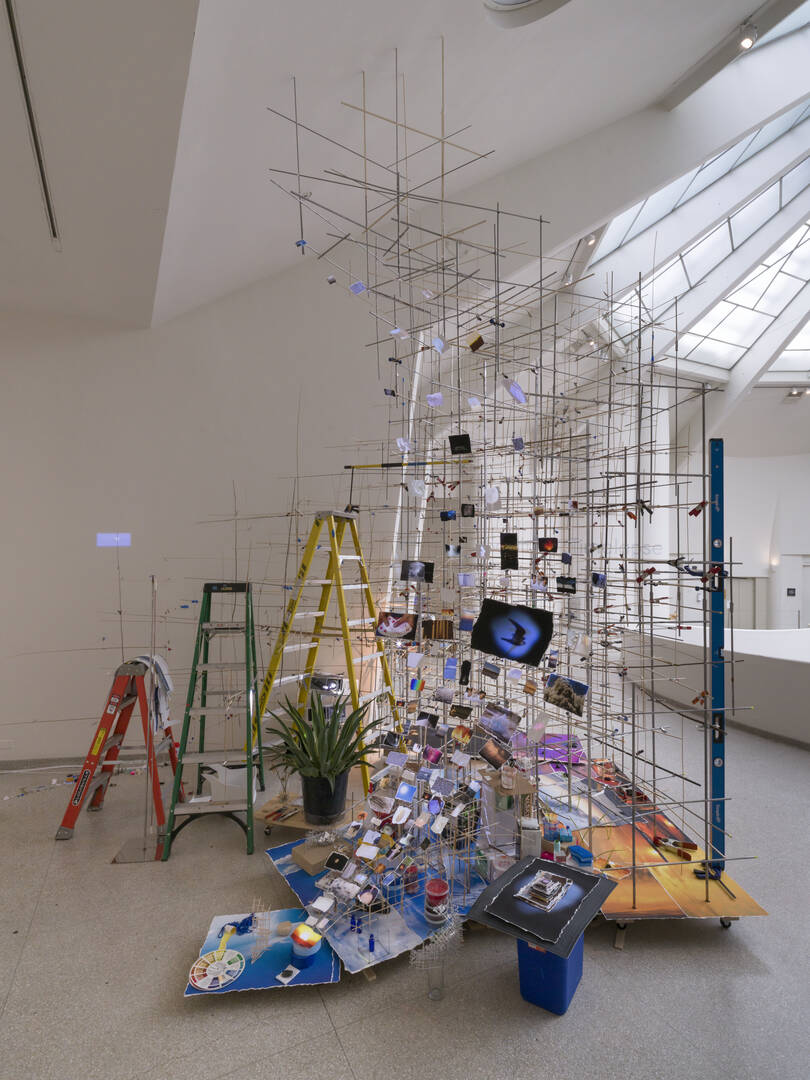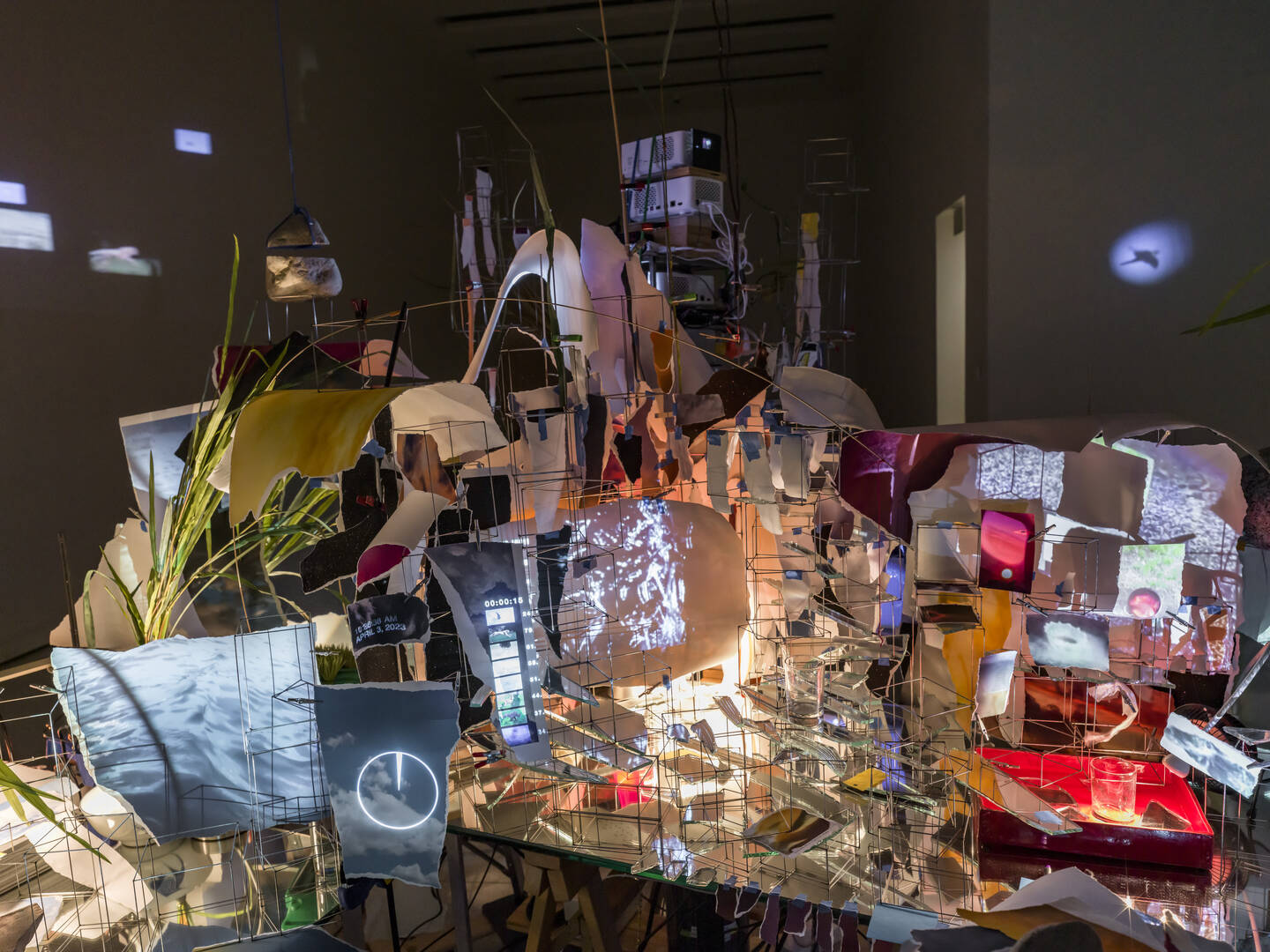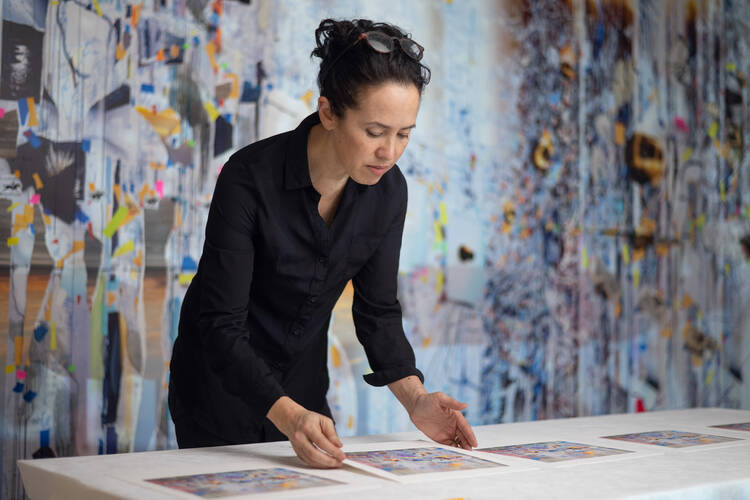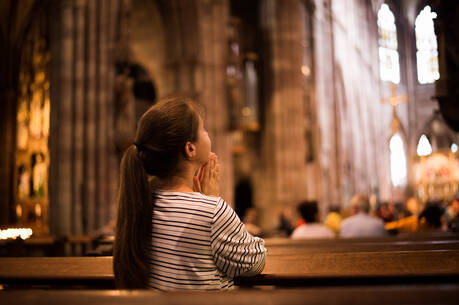Five years ago, I visited the Haus der Kunst, a contemporary art museum in Munich, Germany. My target was an exhibition of works by Kiki Smith (b. 1954), about whom I had taught in courses on theology and visual art. That exhibition was on the second floor; first, I had to pass through the museum’s central hall. The vast space was dark and, except for the massive, Nazi-era columns, largely empty. I noticed, though, a small installation at the hall’s far end, lightly illuminated from within.
I approached. It was a seemingly unstable construction of bamboo sticks, torn paper, video projectors, desk lamps, plastic cups and boxes of salt, arranged like a miniature amphitheater, casting glints of color and stipples of white light outward, across the room and onto the ceiling. I walked around it, allured by how it scattered and hung together all at once. I was afraid to get too close, since it seemed so fragile, but I also could hardly believe how forcefully it stood up to the hulking architecture surrounding it. I went to the Kiki Smith exhibit but returned to this strange little installation, “Centrifuge”(2017). I left the museum thinking about it and I haven’t stopped. So went my first encounter with the work of the American artist Sarah Sze.
Sarah Sze’s art, now on display at the Guggenheim Museum in New York City, prompts me to reflect on how God’s loving presence hums in the background of our lives.
Since that April day in 2018, I have educated myself about Sze’s art, talked about it at scholarly conferences and taught students about it at the College of the Holy Cross. Sze is a visual artist who teaches at Columbia University. I find in her multimedia work, always with her signature—the gathering of disparate fragments from everyday life into visually appealing and somehow, in their diversity, cohesive compositions—a source of viewing pleasure, but also a spur toward thinking about how God’s grace works in our lives. Sze’s art, which is not religious, prompts me to reflect on how God’s loving presence hums in the background of our lives, how God sustains us, how God gathers up the fragments of our lives and assembles them, and how we cooperate with God’s grace to do the same.
I was excited to recently discover that Sze has an exhibition currently on view at the Guggenheim Museum in New York City (March 31–Sept. 5, 2023). I resolved to visit.
The exhibition is called “Sarah Sze: Timelapse”and is curated by Hui Kyung An. It stretches across the facade of the museum (at night, with rotating projected videos traversing the rounded exterior), the central rotunda (a pendulum suspended from a royal blue string, which is tied to others, unifying the entire exhibition), and the sixth and seventh levels of the building. Most works are brand new, from 2023, but two older works are displayed: “Untitled (Media Lab)”(1998), which was the first of Sze’s works to use video, now one of her hallmarks; and “Timekeeper” (2016), a monumental installation that exemplifies Sze’s grappling with the theme of time.

Sze’s dazzlingly colored work shines against the backdrop of Frank Lloyd Wright’s austere off-white walls, and her meticulously articulated constructions pleasingly complement the building’s dignified weight. When I visited, the space was abuzz with activity—within the artworks for sure, but also among the guests. Sze’s work is eminently photographable. Since we are all photographers now, we respond to her dispersal of images, whether through moving projected video or torn inkjet prints on paper, by creating and disseminating our own digital photographic record. Sze’s work reflects self-consciously on the now-outsized role of images in our lives: They’re everywhere, punctuating every moment, almost closer to us than we are to ourselves!
As a painter, I was powerfully struck by “Times Zero” (2023). The painting-collage on the wall is rectangular, but the picture plane is dominated by circular forms, like ripples on water. Indeed, collaged motifs include a photograph of placid waters at sunset; another is an archipelago and surrounding water at midday; still another shows arctic waters with ice floes. The peace of these gently rippling images of water is disturbed, however, by fire: A circular grill flares at the center of the painting’s bullseye; orange paint drips across torn prints; lava flows between patches of blue. Images of hands and of a sleeping young woman course through the rest of the work. This is not all, though. What makes “Times Zero” such a success is how Sze replicates and scatters the painted image. She completed it, photographed it, did a high-quality, full-scale print, tore up the print, and installed that as the painting’s shattered reflection on the plinth beneath. Viewers are challenged to gather the fractured image with their imaginations, and thus to contribute to the work. Brilliant.
Sze composes every one of her works from many elements, all of which remain plainly visible in the final product: sticks and aluminum rods, flecks of dried paint, torn photographs, thread and yarn, mirrors, books, condiment bottles, rocks, office supplies, drinking glasses, clamps, tape measures, ladders, color wheels and jars of gesso. I focused most during my visit on the several almost-imperceptible constants that unite the disparate parts. Projected images revolve around the gallery space, falling alternately on different artworks; clocks tick and mark the passing of each moment; pendulums swing and do the same; and several long, blue strings literally tie together the contents of each bay.

Sze creates an immersive experience. She relates it to the passage of time, which we “keep” in our own ways. ”Timekeeper”features several methods, with rolling stopwatches, graphs of the top running speed of animals, hourglasses and pendulums being just a few. Also, time keeps us. The projected video on the building’s exterior follows lunar phases, the same cycles that affect seasons, tides, plant growth, animal migration and human sleep. Images of all of these phenomena appear throughout Sze’s works.
As I, a theologian and believer, see it, viewers can interpret the unifying constants in “Timelapse” as analogies for the ever-present hum of God’s grace, which sustains our lives even when we do not directly perceive it. Sze’s works confront us with life’s mess, to which we, like the artist, attempt to give order. For believers, we may detect in the mess and the efforts at ordering it the silent operation of God’s loving nearness. Amid, and often over and above, our efforts, God gathers us and pieces us back together. We mark time, our lives’ scattered moments, but, as Karl Rahner might put it, however much we grasp in this life, we are grasped even more.
We can articulate this “being grasped” in terms of the uncontrollable passage of time, as Sze rightly does. This would be to focus on our own finitude. We can also articulate it in terms of God’s nearness to us in grace and God’s holding us up (like Sze’s delicate structures), even or especially when we do not notice. Then we can discover our God-given capacity for the infinite. Medieval theologians used to say that the human soul, as God’s living image, was quodammodoomnia, in some way everything. There’s a holism about us, even when we’re torn up and thrown about—which more often than not, we are.
Sze’s art may not garner the admiration of all. I heard some snickers as I walked through the gallery, the typical posture of some onlookers who seem to insist, “I could do this.” Sze’s art could be seen as just a random arrangement of stuff from around the home, or the office, or the art supply store. For those of us who are Christian, this should capture our interest. God comes near to us in the normal stuff of life. This is not easy to believe, especially for someone on the obsessive-compulsive side like me, who abhors a messy room. Even so, God guarantees it.
The height of God’s self-communication to us comes in Jesus Christ. Before his years of active ministry, Jesus led an everyday life so insignificant, at least for 20 or 30 years, that the Gospel writers left it without comment. When it says in Jn 1:14 that the Word became flesh and dwelled among us, it means that the second person of the Trinity entered our mess, fully and completely, to heal and to rearrange it. Christian life consists mainly of arranging the chaos of the normal stuff of life. This is where God comes near.
Whether or not every onlooker “gets” Sze’s “Timelapse,” I hope that for many people it brings the insight, even if they can’t quite put their finger on it, that there is something sublime about mundane objects and pedestrian moments. As for me, I find in her elevation of the everyday an expression of deep hope: that the drudgery of daily life points to something more, not pie in the sky above us, but rather fullness here, “down and among,” as the theological ethicist Norman Wirzba puts it. Glimpses of redemption here sustain us as we seek resurrected life hereafter.
Five years ago, I did not expect to find Sarah Sze’s art at all, let alone that I would find it so captivating. I’m grateful for the grace it has pointed to and become, how it illuminates God’s nearness.








